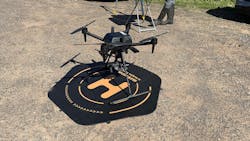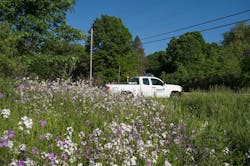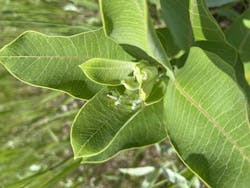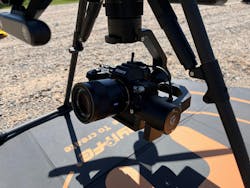Balancing Infrastructure Management and Ecological Conservation in Utility Rights of Way
Utilities have long been at the forefront of environmental stewardship, especially when it comes to cultivating and maintaining pollinator habitats in their rights-of-way (ROWs). But in an era of intense scrutiny and increasingly lean resources, utilities are challenged with how to successfully balance infrastructure management with ecological conservation.
Now the answer could be found in a pilot project that’s poised to transform how utilities monitor and manage their ROWs to achieve compliance and realize significant cost savings.
Got Milkweed?
The idea of protecting pollinators by cultivating habitats in utility ROWs is nothing new. Pollinator-friendly ROWs are helping utilities improve habitats while simultaneously achieving their reliability needs.
This is a good thing, of course, as pollinators, like the monarch butterfly, play an integral role in ecosystem function. But concern over their decline due to habitat loss, disease, parasites and environmental pressures has spurred a variety of conservation efforts. For example, the Rights-of-Way as Habitat Working Group is on a mission to support a healthier ecosystem while also enhancing safe, reliable energy systems by using ROWs as food and shelter for birds, butterflies and other pollinators.
As one of the group’s many coalition partners, The Davey Tree Expert Company is helping further the mission by supporting utilities in achieving their environmental compliance and stewardship goals through planting, maintaining and monitoring ROW pollinator habitats, including milkweed host plants.
Utilities, Monarchs and Milkweed
Why milkweed? Milkweed is the sole host plant for monarchs, making it essential for monarch butterflies to complete their lifecycle. That’s why maintaining a healthy renewable population of monarch butterflies has become so important.
Adam Baker, Ph.D., a research entomologist within the Davey Institute, says that over the past several years, the main conservation strategy for monarch butterflies has been to plant as many milkweeds as possible.
“It’s been proposed that 1.8 billion milkweed stems need to be reintroduced into the flyways and breeding grounds of North America,” he said. “Of course, milkweed is only part of the solution for the monarch, but it is a really big component.”
Milkweed monitoring is a crucial element for utilities wishing to maintain compliance with the Monarch Candidate Conservation Agreement with Assurances (CCAA). This formal, yet voluntary, program of the U.S. Fish and Wildlife Service (USFWS) is dedicated to helping preserve monarch butterfly habitats on lands managed by the energy and transmission sector.
According to Dr. Baker, when a utility becomes part of the CCAA, they’re not only helping conserve the monarch butterfly, but they’re also creating high-functioning ecological assets that provide habitat and are resistant to colonization by invasive species.
“But, in order to create a compliant, low-maintenance, least-disruptive plan for these habitats, utilities must invest in expert vegetation management,” he said. “This includes quantification of keystone species, such as milkweed, which can be used as a proxy for ecosystem health. Accurate counts of milkweed stems provide feedback on habitat improvement activities and ensures compliance with environmental stewardship programs like the CCAA.”
Boots-on-the Ground vs. Technology: Which Is Better for Counting Milkweed?
Traditionally, counting milkweed is a job that’s performed through a literal boots-on-the-ground assessment and physical stem count using methods such as transect-based estimates. It is a labor intensive and time-consuming process that requires high levels of experience and expertise to properly execute the count.
In addition to the expense involved in counting milkweed, there are other challenges associated with conducting a physical count of the plants:
- The amount of time it takes to walk the ROW, identify and count the plants.
- Potential for human error due to fatigue or bias, which can affect the accuracy and consistency of counting.
- Inaccessibility of hard-to-reach areas.
- Worker safety.
Yet, what’s the alternative? The answer: Technology-assisted assessment, of course. Specifically, drone- and machine learning (ML)-enabled data capture and processing.
As an expert in monarch/milkweed interactions, Dr. Baker admits that few people have grown more milkweeds or crawled through chigger-infested meadows as much as he has. He knows how arduous full ground counts of milkweed stems can be. So, when he met entrepreneur Greg Emerick at a monarch summit a few years ago, it only made sense to explore the idea of using Emerick’s conservation platform, POLLi, to assist. POLLi uses drone flights and algorithms to identify milkweed as accurately as an expert, only faster.
From that and subsequent conversations, a pilot project was born between the Davey Institute and POLLi that involved comparing the traditional data collection method of physical counts to drones, AI and ML to quantify milkweed and other floral resources in a sample ROW.
The Pilot Project
“Unlike humans, cameras and machine learning don’t get tired,” said Emerick, founder of POLLi, which promises to deliver fast, affordable insights for conservation, vegetation management and reporting. “I knew that we could capture a bunch of images with metadata and create a machine learning model that could count the plants and identify not only the plant, but also its exact location on earth. I knew that drones could be used for understanding both counts and concentrations.”
Even better, the POLLi platform could take the collected data and process it in a way that nobody else, seemingly, has.
“It’s like emptying your pockets at the end of the day, filling a change jar and having someone ask you to pull out a 1975 dime,” Emerick said. “It’s really difficult. That’s what it’s like when you capture a whole bunch of images like this. Even though we can process it, it’s really hard to manage all of that data and then make it make sense to someone else. That was the impetus for developing our platform.”
Together, that’s what the entomologist and the entrepreneur did. Focusing on a half-mile section of an electric distribution ROW equal to a little over four acres, each went out and did full counts of the milkweed stems; Dr. Baker on the ground and Emerick from the air.
Counting milkweed is not an easy or simple process. Traditional methods mean populations can be easily overlooked, not to mention randomized transect samplings and transect-based extrapolations that can be inaccurate.
Dr. Baker literally walked the ROW, spending more than three hours, combing the section and leveraging his graduate work in monarch butterfly conservation to identify and count close to 600 milkweeds. Emerick then flew a drone over the same area, collecting image data at the proper resolution on the POLLi flight application, importing the image data into the POLLi platform, then processing the data through proprietary algorithms.
In addition to testing the assumption that POLLi could perform as well or better than the traditional method, the collaborators say the other goal was to determine if this methodology could provide utilities with a lower cost, yet highly accurate, option for assessment.
Pilot Project Outcomes
The results were astounding. While not identical in number, the counts — 579 for Dr. Baker and 503 for drone detection — proved promising.
This side-by-side visual comparison shows the difference in both count and time to collect. Note that technology outperformed traditional by not just minutes but hours. In fact, POLLi was 15 times faster.
In addition to speed, here’s a look at some of the other potential benefits of taking data collection to the air — and to scale:
- Time and Cost Efficiency: Drone-enabled collection dramatically reduces data collection expenses by replacing manual, labor-intensive research methodologies.
- Resource Optimization: Automating flight planning and data processing allows utilities to better allocate their organizational resources.
- Enhanced Decision-Making: High-quality, accurate ecological data empowers organizations to make informed conservation choices.
- Sustainable Monitoring: Continuous habitat and species tracking supports adaptive conservation strategies without high, recurring expenses.
- Environmental Protection: Precise ecological data helps prevent potential environmental damage and avoid significant financial and ecological restoration costs.
Scaling and Future Application
Now that the proof of concept is complete, the Davey Institute and POLLi are planning a more formal, follow-up study. In addition to quantifying milkweed stems, the team will compare habitat composition using the pollinator scorecard, Tier II. Details are yet to be announced, but Dr. Baker says the Institute’s work with POLLi is not just about making field work faster.
“Our work is about giving utilities data-informed insights to make cost analyses about converting their ROWs to pollinator habitats,” he said. “It’s about addressing a conservation need while measurably contributing to sustainability objectives. And that’s something that hasn’t been fully addressed—until now.”
Flying High with AI: Mapping Trees, Invasives and Plant Communities
A pollinator ROW isn’t the only vegetation community that utility companies can map and monitor with drones and advanced AI systems, says Will Ayersman, project manager, GIS & Remote Sensing Services, Davey Resource Group (DRG), a subsidiary of The Davey Tree Expert Company.
“There are a variety of other ways utilities can benefit from machine learning and deep learning algorithms,” he said. “Tree species, invasive species and plant community mapping are just the beginning. We can take something we’ve trained the model on a few acres and deploy at thousands of acres. In using this technology for over a decade, we’ve seen how it expedites a lot of different species detection and integrates it with large scale projects and solutions.”
Ayersman offers the following three ways utilities can operationalize drones paired with AI deep learning:
1. Mapping: Deep learning algorithms can be trained to identify specific invasive species from high-resolution drone imagery.
2. Identification and detection: AI can enable pattern recognition, image detection and colorization to assist with identifying and assessing different vegetation communities. Training models with informative field data and overlaying it with images and geospatial datasets provides verified locations, increasing the model’s ability to recognize infestations well before ground crews can.
3. Planning and prioritization: Models can be trained to think logically by running different simulations. This helps in identifying how many acres of a potential invasive species there are so the utility can put together a treatment plan to eradicate or manage the invasive species.
As for what’s next, Ayersman said the advancements in AI are coming fast and furiously and will greatly benefit the utility industry.
“Our input data has made a massive improvement in terms of sensor resolution and specifications. Our understanding of how to build and apply models has, too. We’re looking at 3D imagery overlayed with data like a plant communities map. It’s so immersive it’s like you’re on the site without being on the site. Plus, machine learning and deep learning enable us to retain a library of results that we can continually improve upon.”
About the Author
Jill Rebuck
Jill Rebuck ([email protected]) is a senior project manager in corporate communications for The Davey Tree Expert Company, an employee-owned corporation that provides research-driven tree services, grounds maintenance and environmental and utility infrastructure consulting for residential, utility, commercial and environmental partners in the United States and Canada. Rebuck is a graduate of Kent State University in Kent, Ohio, and holds a bachelor’s degree in public relations.




